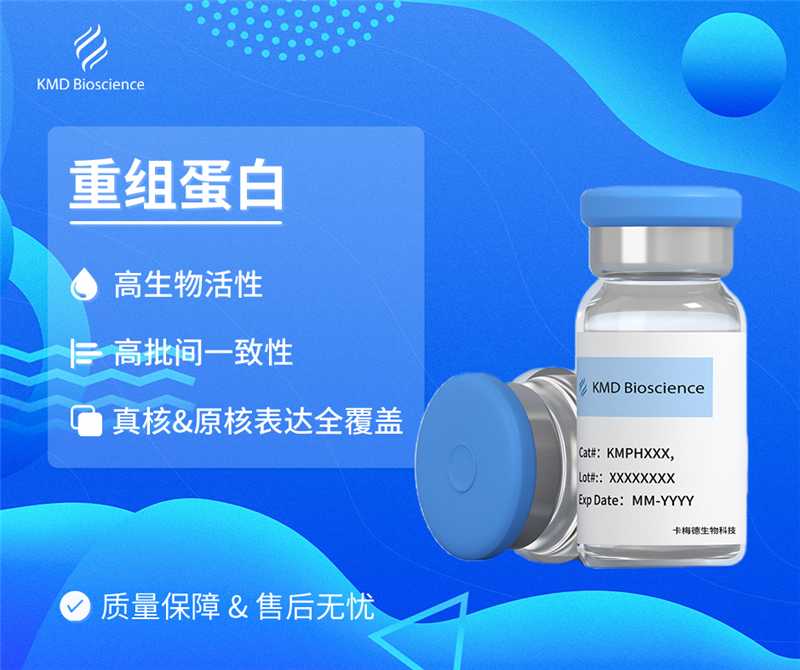| Catalog Number | KRP226 |
| Alias | 骨形态发生蛋白4, Bone morphogenetic protein 4 , BMP-4, Bone morphogenetic protein 2B, BMP-2B, Bmp-4, Dvr-4, Bone morphogenetic protein 4, BMP-4, |
| Size | 20ug, 50ug, 100ug, 200ug, 1mg |
| Product Description | Mouse Bmp4(293-408 aa) |
| Molecular Name | Bmp4 |
| Product Introduction | 骨形态发生蛋白4调节造血系统和免疫系统的生长因子。。 |
| Molecular Weight | 12 kDa |
| Expression System | HEK293F Cells |
| Species | Mouse |
| Concentration | 联系销售经理获得最新批次的浓度 |
| Purity | ≥95% |
| Purification | Affinity Purification |
| Uniprot ID | P21275 |
| Storage Condition | Store the product under sterile conditions after opening at -80℃ for 12 months. Store the lyophilized powder at -20℃. Avoid repeated freeze-thaw cycles. |
| Formulation | Supplied in PBS |
| Shipping Condition | This product is shipped on ice packs or dry ice. |
| Background | Growth factor of the TGF-beta superfamily that plays essential roles in many developmental processes, including neurogenesis, vascular development, angiogenesis and osteogenesis (PubMed:10049358, PubMed:14973287, PubMed:15206957). Acts in concert with PTHLH/PTHRP to stimulate ductal outgrowth during embryonic mammary development and to inhibit hair follicle induction (PubMed:17301089). Initiates the canonical BMP signaling cascade by associating with type I receptor BMPR1A and type II receptor BMPR2. Once all three components are bound together in a complex at the cell surface, BMPR2 phosphorylates and activates BMPR1A. In turn, BMPR1A propagates signal by phosphorylating SMAD1/5/8 that travel to the nucleus and act as activators and repressors of transcription of target genes. Positively regulates the expression of odontogenic development regulator MSX1 via inducing the IPO7-mediated import of SMAD1 to the nucleus (PubMed:34995814). Required for MSX1-mediated mesenchymal molar tooth bud development beyond the bud stage, via promoting Wnt signaling (PubMed:27713059, PubMed:8898217). Acts as a positive regulator of odontoblast differentiation during mesenchymal tooth germ formation, expression is repressed during the bell stage by MSX1-mediated inhibition of CTNNB1 signaling (PubMed:29148101). Able to induce its own expression in dental mesenchymal cells and also in the neighboring dental epithelial cells via an MSX1-mediated pathway (PubMed:8898217). Can also signal through non-canonical BMP pathways such as ERK/MAP kinase, PI3K/Akt or SRC cascades. For example, induces SRC phosphorylation which, in turn, activates VEGFR2, leading to an angiogenic response (By similarity). {ECO:0000250|UniProtKB:P12644, ECO:0000269|PubMed:10049358, ECO:0000269|PubMed:14973287, ECO:0000269|PubMed:15206957, ECO:0000269|PubMed:17301089, ECO:0000269|PubMed:27713059, ECO:0000269|PubMed:29148101, ECO:0000269|PubMed:34995814, ECO:0000269|PubMed:8898217}. |
| Endotoxin | < 0.1 EU per ug |
| Biological Activity | Measured by its ability to induce alkaline phosphatase production by ATDC5 mouse chondrogenic cells. The ED50 forthis effect is 5- 40 ng/mL |
| Product Declaration | 该产品仅供科研使用,不可直接用于人体或注射。 |











 0
0
